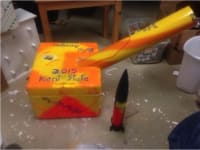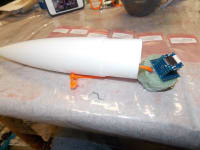Attached to the hydrogen lift balloon will be a solid rocket engine launch sled. When the balloon reaches launch altitude the flight computer will determine any vector changes that need to be made and then initiate launch sequence. The rocket will ignite and propel the payload to appropriate velocity, vector and altitude at which point the rocket and flight computer will drop away from the satellite. The command and control computer on the balloon will be recovered, the launch computer and the rocket stage will NOT be recovered. The launch sled will contain only the minimum needed systems to accomplish launch, vectoring and recovery.
Design Parameters:
Expendable orbital launch system
2 week orbit of a 200 pound payload
Balloon high altitude launch platform
Small solid rocket engine design theory
Expendable model allows for lighter and cheaper structures and construction materials lowering weight and cost. A expendable system is much simpler and lighter because of the lack of flight controls systems, batteries, thermal protection and de-orbiting engines. Limited and inexpensive electronics on board the launcher are interfaced with the command and control balloon and with various sensors through a encoded local network eliminating the wires further reduce weight.
With a classification of Microsat being under 85kg a 89kg payload gives us a slight advantage and acceptable engine failure rating. The two week orbit was chosen based on the needs of many research and testing companies wanting quick results for such a capital investment. A two week orbit could be increase or decrease as needed as could price give us flexibility in situations in order to produce more sales. With mass production of the simple subsystems we can provide a quick turn around option where a company or university wants results of an experiment quickly so they can quick turn prototype themselves.
Ballon launch platform allows minimal need for aerodynamics and aerodynamic structures due to being at below 10inHg in air pressure. Being just outside the atmosphere during launch allows the payload to take on various shapes not limited to the aerodynamic shape of the rocket. The solid rockets are more efficient without the aero drag and the nozzle system has been engineered for low outside pressure operations not like most rockets that operate over a wide range of pressures. This will lighten the launch system and some payloads might not need any environmental protection to launch. All positioning sensors, lunch computer calculations and main communications will be on board the C&C and will be recoverable downwind.
Smaller rocket engines are easier to construct, cheaper, less dangerous, have require less structural components and more reliable. Some of the biggest advantages of the small rocket operations is that large launch facilities aren't necessary and launch site can be based on mission or orbital needs and not facility/support location.
Video
Like this entry?
-
About the Entrant
- Name:Brian Stofiel
- Type of entry:individual
- Software used for this entry:openrocket








